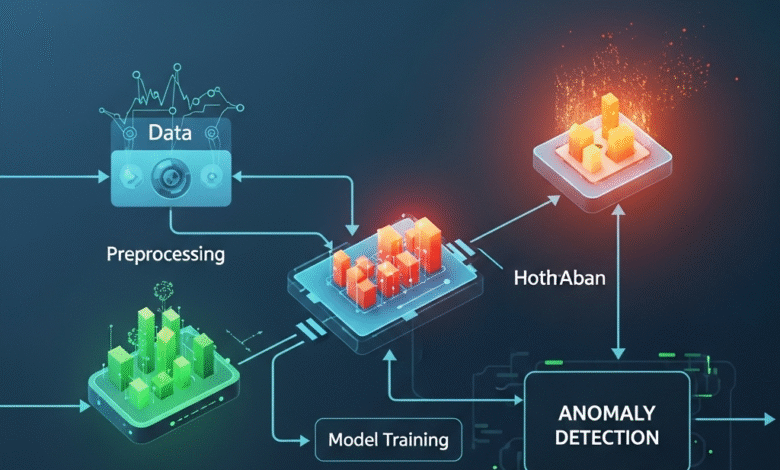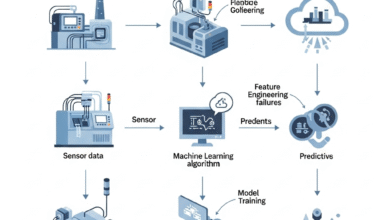Anomaly Detection Machine Learning
Smart Detective for Finding Anomalies in Your Data

Anomaly Detection Machine Learning : Smart Detective for Finding Anomalies in Your Data
Hello Tech Friends! Have you ever imagined having a “super detective” that could:
🚨 Detect fraudulent credit card transactions in milliseconds
🔍 Find hidden production defects among thousands of products
⚡ Monitor factory machine health and predict failures before they occur
🛡️ Identify unusual cyber attacks that slip past regular security rules
This is the power of Anomaly Detection Machine Learning! This technology is like a smart alarm system that learns to understand the “normal” patterns in your data and then highlights anything that deviates (anomalies). The good news: this AI is becoming increasingly sophisticated, accessible, and a game-changer across various industries. Let’s dive into the world of machine learning-based anomaly detection!
What Is Anomaly Detection? A Simple Analogy
Imagine you own a grocery store. Every day, an average of 100 people enter between 10 AM and 6 PM. Suddenly, one Saturday night at 11 PM, the CCTV records 50 people entering at once! That’s an anomaly — an unusual pattern that is suspicious and needs investigation.
Anomaly Detection Machine Learning works similarly, but on a massive and complex data scale. It learns from:
- Historical patterns (like store visit times)
- Relationships between variables (e.g., machine temperature vs. vibration)
- Temporal behavior (e.g., website traffic on weekdays vs. weekends)
When new data comes in, the ML model calculates an “anomaly score.” If the score exceeds a threshold, it shouts: “Hey, something unusual is happening here!”
Why Is Machine Learning Important for Anomaly Detection?
Traditional methods (like if-else rules) have four fatal weaknesses:
- Rigid: Not adaptive to new patterns
- Manual: Requires constant rule updates
- Slow: Not suitable for real-time data
- Miss complex anomalies: Fails to detect unusual multidimensional patterns
Machine Learning solves these issues by:
🧠 Automatically learning from historical data
🔄 Dynamically adapting to changing patterns
⚡ Processing real-time data in milliseconds
🔍 Discovering hidden patterns that are invisible to humans
3 Main Types of Anomalies That ML Can Detect
-
Point Anomalies
- Example: A transaction of Rp 500 million in an account that usually has a maximum transaction of Rp 5 million.
- Detection Method: Compare with user behavior profile.
-
Contextual Anomalies
- Example: A spike in jacket sales in July (summer) — normal if it occurs in Indonesia, but strange if in Sweden.
- Detection Method: Consider time/location dimensions.
-
Collective Anomalies
- Example: Machine vibration sensors show an unusual “up-down” pattern repeatedly, while it is usually stable.
- Detection Method: Analyze sequences (sequential patterns).
5 Leading Machine Learning Algorithms for Anomaly Detection
-
Isolation Forest
- Concept: “Isolating” anomalies like finding a needle in a haystack.
- Advantages:
- Fast for large datasets
- No need for data distribution assumptions
- Suitable for: Fraud detection, network monitoring
python4 linesClick to close
from sklearn.ensemble import IsolationForestmodel = IsolationForest(contamination=0.01) # 1% of data considered anomalies… -
Autoencoders (Deep Learning)
- Concept: Neural networks that learn to “compress” normal data and then reconstruct it. Anomalies have high reconstruction error!
- Advantages:
- Reliable for complex data (images, IoT sensors)
- Captures non-linear patterns
- Suitable for: Visual defect detection, anomalies in time-series
-
One-Class SVM
- Concept: Creates a strict “boundary” around normal data. Anything outside the boundary = anomaly.
- Advantages:
- Effective in high-dimensional space
- Robust to noise
- Suitable for: Cybersecurity, rare disease detection
-
DBSCAN (Density-Based Clustering)
- Concept: Anomalies are points that are rare and isolated from dense clusters.
- Advantages:
- No need to specify the number of clusters
- Detects arbitrarily shaped anomalies
- Suitable for: Geolocation fraud, social network analysis
-
LSTM Networks (For Time Series)
- Concept: A specialized RNN that remembers long temporal patterns. A significant prediction error? That’s an anomaly!
- Advantages:
- Understands temporal context
- Detects collective anomalies
- Suitable for: Predictive maintenance, ICU patient monitoring
Real-World Use Cases: Where Anomaly Detection ML Takes Action
💳 Finance & Fraud Detection
- Example: Banks using ML for:
- Detecting fraudulent credit card transactions in 50ms
- Identifying concealed money laundering patterns
- Preventing account takeovers based on unusual login behavior
- Impact: Bank XYZ reduced fraud by 40% with a hybrid model of Isolation Forest + LSTM.
🏭 Industrial IoT & Predictive Maintenance
- Example: Sensors in automotive factories monitor:
- Strange vibrations in press machines
- Unusual temperature fluctuations on conveyors
- Hydraulic pressure patterns outside normal limits
- Impact: Company ABC saved $2M/year by avoiding machine downtime.
🛒 Retail & Customer Behavior
- Example: E-commerce tracking:
- Sudden high-value purchases
- “Add to cart -> checkout” click patterns too fast (possibly bots)
- Deviations in seasonal shopping patterns
- Impact: Tokopedia detected 15,000 bot accounts during a flash sale.
🩺 Healthcare & Medical Diagnosis
- Example: AI analyzes:
- Lab results with extreme values (e.g., suddenly high heart enzyme levels)
- Abnormal EKG patterns that doctors missed
- Anomalies in MRI/CT scan images
- Impact: An AI startup detected early-stage tumors with 92% accuracy.
🌐 Cybersecurity & Network Protection
- Example: ML systems monitor:
- Sudden network traffic from unknown locations
- Suspicious API request patterns (DDoS attacks)
- User activity at unusual hours
- Impact: Cisco reduced false positives by 70% compared to rule-based systems.
Challenges in Anomaly Detection ML (and Their Solutions!)
| Challenge | Smart Solution |
|---|---|
| Imbalanced Data | Use Synthetic Minority Oversampling (SMOTE), anomaly injection |
| Rare Data Labels | Apply unsupervised algorithms (Isolation Forest, Autoencoder) |
| High False Positives | Optimize thresholds, ensemble models, human-in-the-loop confirmation |
| Concept Drift | Real-time monitoring + automatic retraining |
| Interpretability | SHAP/LIME for explainable AI, anomaly pattern visualization |
The Future of Anomaly Detection Machine Learning
-
Generative AI for Synthetic Data
- Models like GAN create synthetic anomaly data for training models.
-
Edge AI for Real-Time Detection
- Lightweight models (TinyML) run on IoT devices without cloud.
-
Explainable AI (XAI)
- Not just detection, but also explaining why something is considered an anomaly.
-
Multimodal Anomaly Detection
- Combine text, images, sensors, and audio in a single analysis.
-
Large Language Models (LLM) as Detectors
- Models like GPT-4 can identify anomalies in system logs or financial reports.
How to Start Implementation in 5 Steps
- Define “Normal”: What are the criteria for healthy data in your system?
- Collect Historical Data: At least 6-12 months of complete data (including examples of anomalies if available).
- Choose an Algorithm:
- Tabular data → Isolation Forest
- Time-series → LSTM
- Complex images/signals → Autoencoders
- Build a Pipeline:
- Diagram

- Code
graph LR A[Data Streaming] --> B{Preprocessing} B --> C[Model Inference] C --> D[Skor Anomali] D --> E[Alert jika > Threshold] E --> F[Dashboard Human Review]
- Diagram
- Continuously Monitor & Retrain: Every 1-3 months, evaluate model performance!
Popular Tools You Can Try
- Open-Source: Scikit-learn (Isolation Forest), PyOD (Python Outlier Detection), TensorFlow (Autoencoders)
- Cloud Services: Azure Anomaly Detector, AWS Lookout for Metrics, Google Cloud Vertex AI
- Low-Code Platforms: DataRobot, H2O.ai, Anaconda Enterprise
Conclusion
Anomaly Detection Machine Learning is your super eyes and ears in the chaotic data world. It’s not just an “error finder,” but a proactive system that prevents losses, enhances security, and optimizes operations.
With the explosion of IoT, digital transactions, and complex systems, the ability to detect anomalies is no longer a nice-to-have — it’s a critical necessity. The good news: thanks to advancements in ML, user-friendly tools, and cloud support, its implementation is becoming more affordable.
Ready to become a data detective? Start with a small dataset, experiment with different algorithms, and see how AI can unveil unexpected insights! Have any anomaly detection experiences? Share in the comments! 👇😊
FAQ (Frequently Asked Questions)
Q: What is the difference between anomaly detection and outlier detection?
A: Outlier detection focuses on extreme statistical data points, while anomaly detection encompasses more complex contextual/collective patterns.
Q: Can anomaly detection ML work without labeled “anomaly” data?
A: Yes! Unsupervised methods (like Isolation Forest) are specifically designed for this.
Q: What is the best evaluation metric for anomaly detection models?
A: Precision-Recall AUC (due to imbalanced data). F1-score is also relevant.
Q: How much data is minimally required?
A: Ideally >10,000 samples, but for simple methods, you can start with 1,000 data points.
Q: Can anomaly detection be run in real-time?
A: Absolutely! With streaming architecture (Kafka, Spark Streaming) and optimized models, responses <100ms are very possible.





